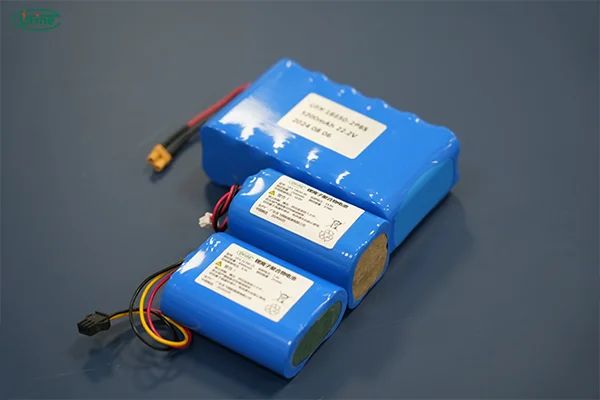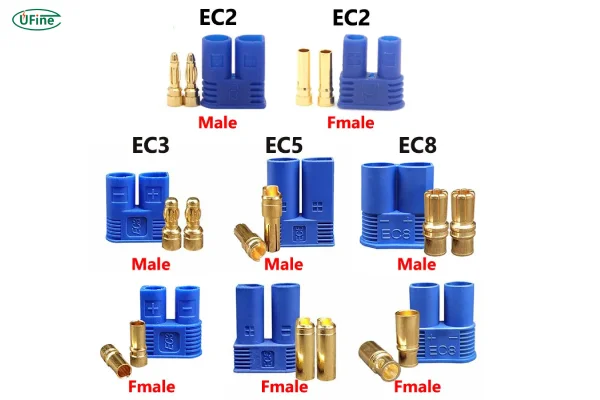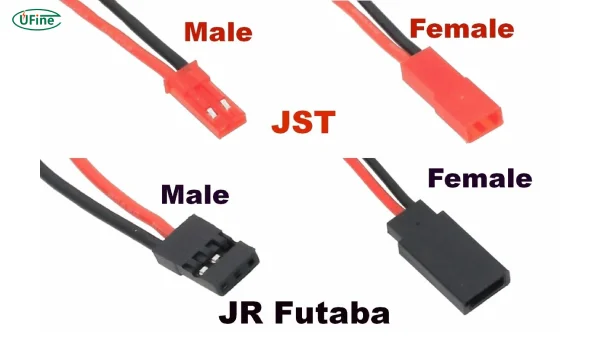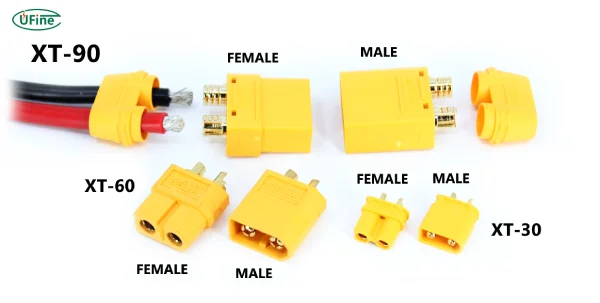Part 1. Learn about LiPo battery connectors
A LiPo battery connector is a critical component that connects the battery to a device or charging system. These connectors allow the flow of power between the battery and the device it powers, such as drones, RC cars, or other electronic equipment.
LiPo connectors are typically made of two parts:
- The male connector (on the battery side)
- The female connector (on the device or charger side)
The connectors are designed to ensure a secure and efficient flow of electricity. They are also made to handle the high currents that LiPo batteries can produce, ensuring safe operation without overheating or damage.

Part 2. How does LiPo battery connector affect battery performance?
The type of LiPo battery connector you choose directly impacts the performance and efficiency of your battery. A good connector ensures that the current flows efficiently without excessive resistance, which can cause:
- Voltage drop
- Heat buildup
- Reduced battery life
What Is the Lithium Battery Short Circuit?
If the connector doesn’t fit tightly or is of poor quality, it may cause power loss or create a safety hazard. A poorly connected battery might also result in sparking or short-circuiting, both of which can damage the battery or device.
Part 3. Typical types of LiPo battery connectors
LiPo batteries come with a variety of connectors to suit different applications and power needs. Below are some of the most common LiPo battery connector types:
- XT60: One of the most popular connectors, known for its durability and solid connection.
- XT90: A larger version of the XT60, used for higher-power applications.
- EC3, EC5, EC8: Common in RC applications, these connectors are known for their easy-to-use design and reliability.
- JST: A small and lightweight connector, typically used in smaller, low-power devices.
- JR: Often found in RC applications, they are highly reliable and capable of handling moderate power loads.
- Deans: Known for their compact design and secure connection, Deans connectors are frequently used in hobby and RC applications.
Part 4. Why are there so many types of LiPo battery connectors?
The variety of LiPo battery connectors exists to accommodate different power requirements, device sizes, and performance levels. Batteries used in devices such as drones, RC cars, or robots have varying power needs. A connector that works well for a small, low-power device might not be suitable for a high-performance drone that demands a lot of power.
Additionally, different connector types are designed to handle specific amperage levels. For instance, an XT60 connector might be sufficient for a standard RC car, but for large drones or high-power systems, a more robust connector like XT90 is needed.
Ufine Battery can customize LiPo battery connectors to fit your specific needs, whether you require higher amperage, smaller sizes, or a connector designed for a particular type of device.
Part 5. What are the two connectors on LiPo batteries?
LiPo batteries typically have two connectors:
- Main Power Connector: This is the primary connector used to power the device, such as a drone, RC car, or other electronics.
- Balance Connector: This secondary connector is used to balance the charge across all cells in the battery, ensuring safety and efficiency. It helps prevent overcharging or undercharging individual cells, which could lead to battery damage or safety hazards.
The main connector handles the high current flow, while the balance connector manages the charging process to ensure optimal battery health. The presence of both connectors allows for efficient power delivery and safe operation.
Part 6. Comparison of the pros and cons of EC3, EC5, and EC8 LiPo battery connectors
- EC3 Connector:
- Advantages: Affordable, reliable, and compact. Suitable for small to medium applications.
- Disadvantages: Limited for higher currents (up to 60A).
- EC5 Connector:
- Advantages: Can handle higher currents (up to 120A), durable, commonly used in mid-size RC vehicles and drones.
- Disadvantages: Larger size compared to EC3, which may not fit in tight spaces.
- EC8 Connector:
- Advantages: Ideal for high-power applications, supporting up to 150A. Great for larger RC vehicles or drones.
- Disadvantages: Bulky, may be difficult to fit in smaller devices.
Part 7. Comparison of the pros and cons of JR and JST LiPo battery connectors
- JR Connector:
- Advantages: Reliable and commonly used in RC systems. Handles moderate current well and is widely supported.
- Disadvantages: Larger than the JST connector, not ideal for very low-power devices.
- JST Connector:
- Advantages: Small, lightweight, and efficient for low-power devices. Commonly used in smaller drones or devices requiring less current.
- Disadvantages: Not suitable for high-power applications due to its limited current capacity.
Part 8. Comparison of the pros and cons of XT30, XT60, and XT90 LiPo battery connectors
- XT30 Connector:
- Advantages: Small and lightweight, suitable for small drones and RC vehicles.
- Disadvantages: Limited current capacity (up to 30A).
- XT60 Connector:
- Advantages: Strong current handling (up to 60A), reliable, and widely used in drones and RC cars.
- Disadvantages: Bulkier than XT30, which may be a consideration in space-constrained applications.
- XT90 Connector:
- Advantages: Handles up to 90A, ideal for high-power applications like large drones or RC trucks.
- Disadvantages: Larger size, may not be compatible with smaller devices.
XT60 vs. XT90 Battery Connector Comparison
Part 9. How to select the right LiPo battery connector?
Choosing the right LiPo battery connector depends on your application’s power requirements and size constraints. Here are some tips:
- Current Demand: Ensure the connector can handle the required current. Higher-power devices need connectors rated for higher amps.
- Size Constraints: Smaller devices require smaller connectors like XT30 or JST, while larger devices might need XT60, XT90, or EC5.
- Application Type: Match the connector type to the type of device. For instance, XT60 is popular for drones, while JST is used in low-power systems.
If you have specific needs, Ufine Battery can customize LiPo battery connectors to ensure optimal compatibility and performance for your devices.
Part 10. Final words
Understanding the various types of LiPo battery connectors and their advantages will help you select the right one for your device. Whether you’re working with RC vehicles, drones, or other high-power applications, choosing the correct connector ensures optimal performance and safety. If you need a custom solution, Ufine Battery can provide tailored connectors to suit your exact requirements.
Related Tags:
More Articles

How to Choose the Best Floor Scrubber Battery for Commercial Cleaning?
Selecting the ideal floor scrubber battery ensures a long runtime, rapid charging, and minimal maintenance for efficient commercial cleaning operations.
Battery for Blower vs Battery for Leaf Vacuum: Which One Should You Choose?
Battery for blower vs leaf vacuum—learn the key differences in power, fit, and runtime to choose the right battery for your outdoor tool needs.
How to Choose the Right Battery for Blower?
Choosing the right blower battery? Consider voltage, capacity, chemistry & usage. This guide helps match the best battery for peak performance.
How to Choose the Best Insulated Battery Box for Lithium Batteries?
Choosing the Best Insulated Battery Box for Lithium Batteries? Discover key factors such as size, material, and safety for optimal protection and performance.
7 Critical Elements on a Lithium Battery Shipping Label
What must be on a lithium battery shipping label? Learn 7 key elements to ensure safety, legal compliance, and correct handling across all transport modes.






